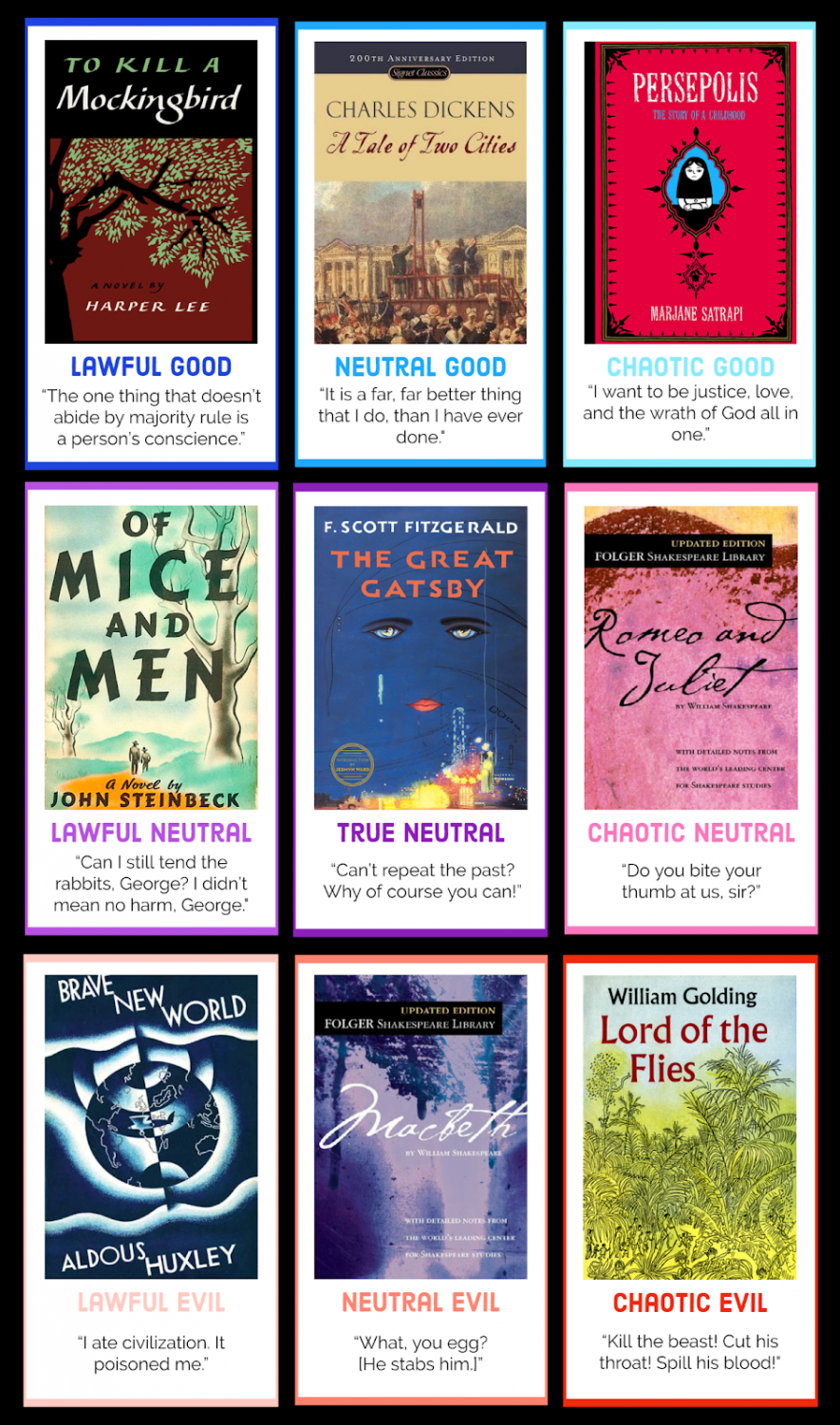The nine alignments: high school literature edition
November 24, 2020
When my friends asked me to rank the books we read for English class, I encountered a dilemma: from feel-good stories to dystopia to downright tragedy, the selection is simply too diverse to rank on a numerical scale from best to worst. I needed a multi-dimensional ranking system, and that’s why the Dungeons & Dragons alignment chart made perfect sense.
To Kill a Mockingbird
If the alignment chart can be understood as a scale of feel-good to disturbing, Harper Lee’s To Kill a Mockingbird is the ultimate feel-good story.
Told from the perspective of a little girl, To Kill a Mockingbird beautifully weaves a coming-of-age tale with small-town life and the clashing of morals in the Depression-era South. The story follows Scout Finch’s childhood as she explores the racial tensions within her community and supports her father, Atticus, as he goes against the whole town to defend an innocent black man. While Atticus works on the man’s case, Scout spends her time reading to Mrs. Dubose (an elderly neighbor whose ill temper and racism she abhors) and making up frightful stories about Boo Radley (the mysterious reclusive neighbor). Scout, prone to making childish judgments of others, learns from her father the value of walking in other’s shoes, something the white supremacist community in her town seems incapable of.
With wholesome characters, colorful narration, and a strong moral message, To Kill a Mockingbird stands out from the high school book list as the most uplifting read. Take a child’s ideals and shine them on society’s prejudices, and you’ll have the prime example of “lawful good.” After all, what can be more “lawful good” than having a protagonist who literally uses the law to fight for good?
Lord of the Flies
But with the beast inside, there’s nowhere we can hide. If there is a song lyric that perfectly sums up Lord of the Flies, it’s this line from “Demons” by Imagine Dragons.
Lord of the Flies is about the dramatic transformation of a group of British schoolboys when a plane crash leaves them stranded on a deserted island. The boys quickly form two opposing tribes led by Ralph and Jack, who emerge as the group’s natural leaders. Ralph, a pragmatist, stands for order and civilization, while Jack, an egomaniac, is the personification of barbarism and, well, everything else that defies civilization. The conflict between these characters is the fight between the angel and the beast that lives in all of us, according to William Golding.
As the polar opposite of To Kill a Mockingbird, this book challenges everything you believe about children’s innocence. With a combination of moral decay and physical destruction, Lord of the Flies secures the “chaotic evil” spot in my chart. Sophomores, believe me when I say that Lord of the Flies might be the most traumatic reading experience of your high school career.
The Great Gatsby
So Atticus Finch is too good for this world; Jack and his followers too evil. If you’re just looking for average characters who have an on-again, off-again relationship with their moral compass, you can find them in The Great Gatsby.
Set in New York during the Roaring Twenties, The Great Gatsby follows the life of a man by the same name who finds his way from rags to riches in hopes of winning over Daisy, a member of the established upper class with whom he shares a romantic past. Now that sounds all good and grand, except it took Gatsby so long to get there that Daisy has already married someone else and . . . let’s just say he got his hands dirty along the way. Still, Gatsby naively hangs on to his impossible dream, only to be bogged down by materialism, dishonesty, and an utter failure to leave the past behind.
The story of Gatsby is where passion becomes reckless ambition and dreams turn into mere fantasies. Whether readers decide to criticize or sympathize with this protagonist, one thing is for sure: he needs a reality check. In true modernist fashion, Scott Fitzgerald’s novel unreservedly brings out the good, the bad, and the ugly in life, making it the “true neutral” book in my chart.



